The Day of the Dead in Mexico
The Day of the Dead or „El día de los Muertos“ is one of the most popular holidays in Mexico. The holiday includes two days. On the 1st of November or "Día de los Angelitos" (Day of the Little Angels) Mexicans celebrate babies and children. On the 2nd of November or "Día de los Muertos" or "Día de los Difuntos" (Day of the Dead) people of Mexico honour the deceased grown-ups.
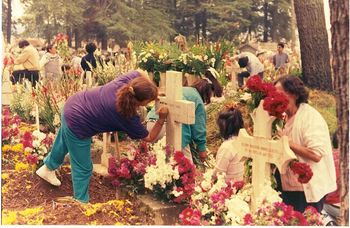 People at the cemetery
People at the cemetery
This is a holiday when people remember dead family members. People build special altars which include – sugar skulls, Marigold (Tagetes) flowers, food and drinks the deceased used to love. People also visit cemeteries and pray for their loved ones who died.
The origins of this holiday are some 2500-3000 years ago in rituals commemorating the death of ancestors by numerous Indigenous nations (Olmec, Zapotec, Mixtec, Mexican or Aztec, Maya, P'urhépecha, and Totonac) from what is now Mexico. Skulls were kept as trophies. The owners of those skulls presented them as symbols of death and rebirth.
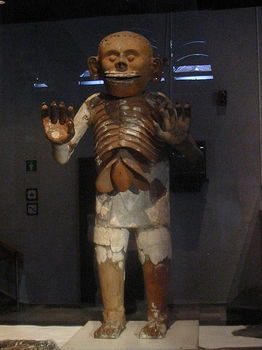 Mictlantecuhtli
Mictlantecuhtli
There was an ancient Aztec festival which honoured the goddess Michtecacihuatl or Lady of the Dead. She was the Queen of "mictalan" (the underworld). She ruled together with her husband Mictlantecuhtli. Her duty was to take care of bones of deceased people.
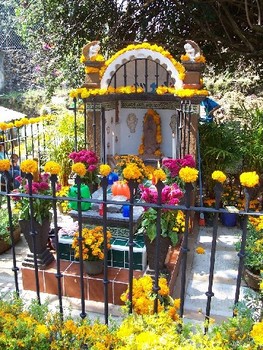 Decorated grave in Mexico
Decorated grave in Mexico
For most Mexicans the Day of the Dead is a good day for communication between the living and the dead. That is why all Mexican cemeteries are full of people on this day. Graves have special decorations. People build sort of altars which include food, beverage and other objects dearest to the dead person.
Different generations of the deceased get different presents - dead children ("los angelitos" or "angels" get toys, famous Mexican beverages like tequila, mezcal, pulque and atole are very commonly given to dead adults. Sweets are dear to everyone. So, dead persons of all generations have them on their graves. Everything brought is called "ofrendas" or offerings.
Time spent at the cemetery on the Day of the Dead differs from place to place. In some towns like Mixquic, Pátzcuaro and Janitzio people stay there whole night.
Plans for these altars are made a year ahead. What is the meaning of these altars? They suppose to be kind of bait or encouragement for the dead person to hear the prayers and comments of people who arrived at the cemetery. There is lot of humour in everything.
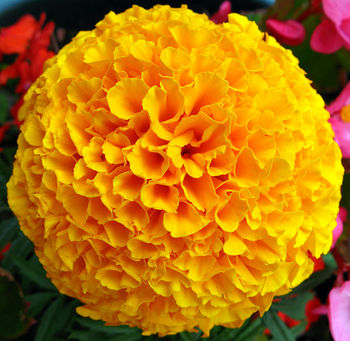 Marigold
Marigold
Flowers are put on graves too. The most popular flowers for the occasion are orange marigolds called "cempasúchitl". Its name comes from "cempoalxocithl" which in ancient Indigenous Nahuatl language means "twenty (many) flowers". Nowadays Mexicans, due to its dominant use, call it "Flor de Muerto" ("Flower of the Dead"). They suppose to attract dead person to the offerings.
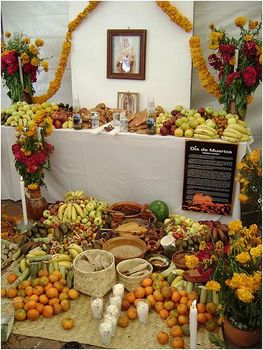 Ofrendas (offerings)
Ofrendas (offerings)
The offerings are often put in homes. There they include traditional food like candied pumpkin, "bread of dead" ("pan de muerto"), skulls made of sugar and different beverages. Offerings are put in homes to welcome the soul of dead person.
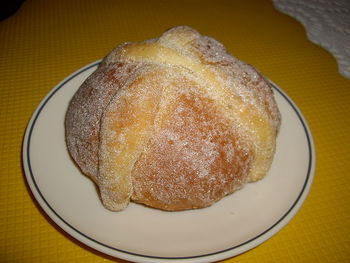 Pan de muerto (bread of dead)
Pan de muerto (bread of dead)
Some people believe that dead person can somehow "suck out" the nutritional substances in food. So, people say that food put at the altar is not so healthy. The journey from the "other side" can make everyone rather tired. That is why Mexicans prepare pillows and blankets for the dead person to rest a bit.
The altars created in home include the cross, picture or sculpture of Virgin Mary and photos of the deceased person(s). Members of family gather around the altar. They pray and tell stories from the life of the dead person. Some sort of altars are also built in schools, government offices etc.
The holiday includes elements of literature. Many "poets" create "calaveras" ("skulls"). The calaveras are epitaphs (few lines of text usually written on grave stones) in which the great moments in life are described.
Such epitaphs first appeared in Mexican newspapers of the 18th-19th century. Epitaphs of famous public figures with cartoons were published there. One of the most famous authors of calaveras was José Guadalupe Posada (1852 – 1913).
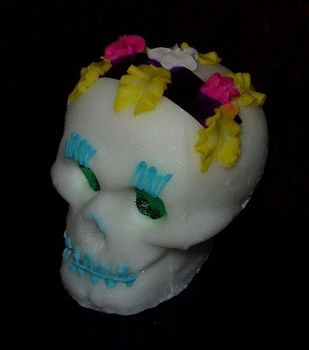 Calavera made of sugar
Calavera made of sugar
Calavera is not only a funny epitaph. It is also a skull which is the most famous symbol of the holiday. It appears in many different forms.
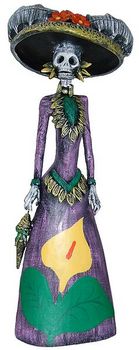 Calaca
Calaca
A calaca (in Mexican Spanish – skeleton) is a figure of skull or whole skeleton wearing human clothes. The calaca very often carries some marigold flowers and foliage. Calacas are usually joyous characters. They play musical instruments or dance. Mexicans believe that every soul should be remembered as a happy one. The death should be a moment filled with joy.
Calacas used during the holiday include carved skull masks worn by dandies, small figures made of carved wood or clay, and sweets in the shape of skulls or skeletons.
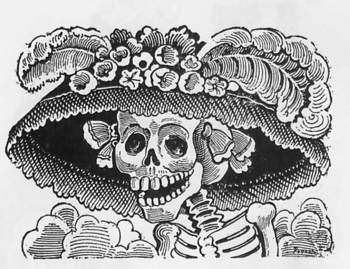 La Calavera de la Catrina
La Calavera de la Catrina
Already mentioned José Guadalupe Posada made the print titled "La Calavera de la Catrina" ("calavera of the female dandy"). The print is a parody showing a Mexican high society woman. Catrina figures similar to the one presented at the print are very popular in the Day of Dead today.
For one more variation of the holiday let's move to the city of Pátzcuaro ("city of stones" in the Purepecha language). This city with population of 51,124 (2007) is located in the central part of Mexican state of Michoacán ("place of the fishermen" in Nahuatl Michhuacān language).
If the dead person is a child, godparents in Pátzcuaro on the 1st of November put sweets, fruits, pan de muerto, a cross, a Rosary and candles on the table set in parents' home. Such a table is sort of celebration of child's life.
On this day streets of Pátzcuaro are full of people dancing. Dancers wear wonderful costumes, skull-shaped and devil masks.
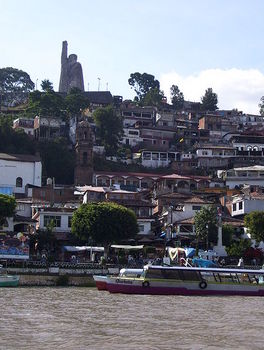 Island of Janizio, Michoacan
Island of Janizio, Michoacan
The 2nd of November is rather special day too. At midnight people of Pátzcuaro carry candles and travel to the island of Janizio located in the middle of lake. They sail in boats called "mariposas" (Spanish for "butterflies"). People go there to honour the dead at local cemetery.
The next tradition for the Day of Dead takes us to the Mexican state of Morelos located next to the country's capital. To enter the house in Ocotopec where someone has recently died visitors give "veladoras" (small wax candles) and that way show respect for people. In return visitors get tamales and beverage called atole. What is the tamale? Mexican call it "tamal" (tamalli in Nahuatl language). It is a dish consisting of of steam-cooked corn dough ("masa") with or without a filling. Tamales are filled with meat, cheese or sliced chillis.
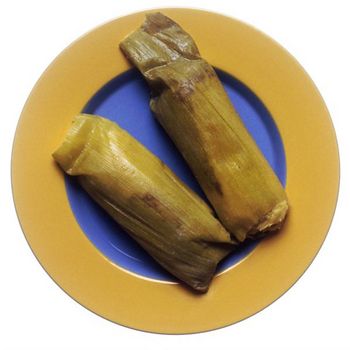 Tamales
Tamales
In cities some newer traditions are appearing. Children put masks, wear costumes. They go from house to house or just talk to someone passing by. People give them some candies or money.
Finally, let's mention a belief that connects objects used during the Day of Dead and happiness. People believe that there is a connection. Some people have tattoos or carry dolls believing that they are going to bring them luck.